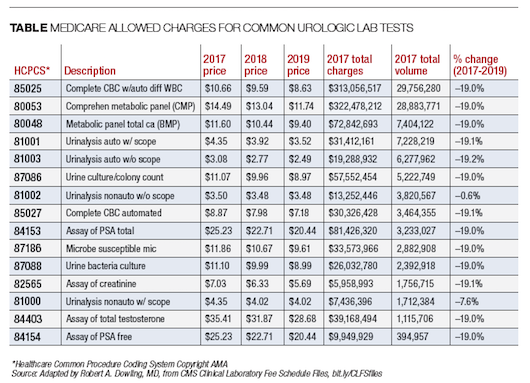Article
How recent legislation has affected payment for lab tests
Author(s):
"Automated urinalysis codes declined 19%, while the manual urinalysis codes without and with microscopy dropped 0.6% and 7.6% respectively over the 3-year period," writes Robert A. Dowling, MD.
Darren Baker - stock.adobe.com


One of the signature health care-related pieces of legislation that has gone somewhat unnoticed is the Protecting Access to Medicare Act of 2014 (PAMA). I have discussed one provision of this law in previous articles-Appropriate Use Criteria for Certain imaging Services-that will significantly impact urologists beginning in 2020 (“How will regulatory changes affect EHR use in your practice?”, June 2018, page 30). Another provision that has already had a significant impact is a restructuring of the policies and fees for clinical laboratory tests. In this article, I will discuss this provision and what you should know as a urologist who orders and/or performs these tests in your practice.
Clinical Laboratory Fee Schedule created
Medicare Part B covers most lab tests and pays 100% of allowable charges (no patient copay)-whether they are performed in independent labs, hospitals, or physician offices. PAMA reformed the payment for clinical laboratory (lab) tests by replacing a system based on historical lab charges and 57 regional rates with a single national fee schedule effective January 2018.
Also by Dr. Dowling: Losing patients to follow-up? Here’s what you can do
The new system is known as the Clinical Laboratory Fee Schedule and is based on payments to private payers during the first half of 2016 and reported to the Centers for Medicare & Medicaid Services in 2017; it is scheduled to be updated every 3 years.
In a recent report, the Inspector General of the Office of Health and Human Services reported utilization data for common tests; additional data are available from CMS and form the basis for this article.

In 2017, over 400 million lab tests were ordered by 656,000 Medicare providers on 28 million beneficiaries, resulting in over $7 billion in Medicare payments (bit.ly/OIGpaymentdata). The average number of tests ordered per provider per year (2017) was 466; information is not available by specialty. Most of these lab payments (65%) were for 25 common tests, and 30% were for five tests: (TSH, CMP, CBC, lipid profile, and vitamin D3 level).
The table shows a list of lab tests commonly performed in urology practice-owned labs. 2019 rates are about 19% lower than 2017 rates for almost all of these commonly performed tests. For example, total PSA was reimbursed $25.23 in 2017 and $20.44 in 2019 (–19%). This was the 20th most common lab test reimbursed by the Medicare Part B program in 2017 and ranked 15th in terms of total payments.
Serum testosterone, urinalysis codes see decline
Serum testosterone similarly declined 19% from $35.41 in 2017 to $28.68 in 2019 (rank 57 in number of payments). Automated urinalysis codes also declined 19%, while the manual urinalysis codes without and with microscopy dropped 0.6% and 7.6% respectively over the 3-year period.
Read: How to improve patients’ access to their health information
Bottom line: Covered lab tests are reimbursed by Medicare Part B with no patient responsibility, and expenditures in the program have been relatively stable. PAMA introduced a national fee schedule that has lowered reimbursement almost 20% on common lab tests-including those tests commonly performed in an office setting or practice-owned lab.
Contact us! Email your comments to urology_times@mmhgroup.com

















